Notes from a recent journey going counter-clockwise around Iran, visiting places such as Tehran, Shiraz, Persepolis, Esfahan, Yazd, Meybod, Meymand, Kerman, Mahan, Mashhad and more.
Touchdown in Tehran
Imam Khomeini Airport was not exactly a party zone late in the evening, and the passport control was extremely tedious, but here we are. Rolled out of the airport and found ourselves thrust into the belly of Tehran’s traffic beast. I’ve seen my fair share of chaos in Cairo and Bangkok, but this was next level. The taxi cut through lanes like a drunk knife through butter.
Quickly dropped the bags at the dodgy hotel in Gohar Shad Alley and went looking for food. It was close to midnight and the streets were deserted. A metropolis of millions, and yet we might’ve been the only souls out. I flicked on my Lonely Planet’s “Nightclubs” chapter for Tehran. It only consisted of one paragraph with two sad words: “Dream on”.
- Related blog post: Tales from Tehran
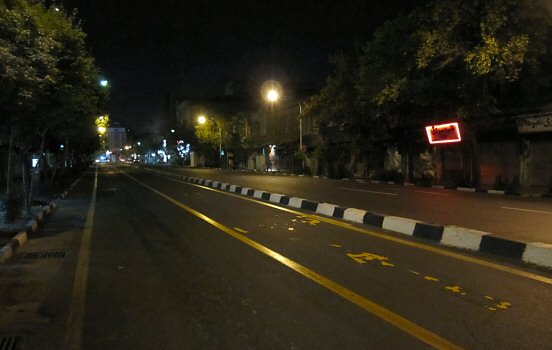 Saturday night in Tehran. Dream on.
Saturday night in Tehran. Dream on.
Onward to Shiraz
Morning in Tehran. Looked for a quick coffee in Jamali Alley, found something resembling hot mud in a Styrofoam cup. The day was kick-started with a fierce taxi ride through the busy streets. I enjoyed chatting with the driver who played loud music and told me repeatedly that he really hated the city. We drove past the gigantic Azadi Tower, which looked more like Sauron’s vacation home than a symbol of freedom. Suddenly the ride ended with a car crash, making a big dent in my passenger door.
Later in the afternoon, we arrived in the city of Shiraz. Dropped the backpacks at a hotel and walked across Hamzeh Bridge. Even though the traffic was insane, Shiraz still felt like a whisper compared to Tehran’s roar.
We aimed for great dome in the distance and soon entered the magnificent Imamzadeh-ye Ali Ebn-e Hamze. The tomb of Emir Ali was placed in the center, surrounded by dazzling Venetian mirror work.
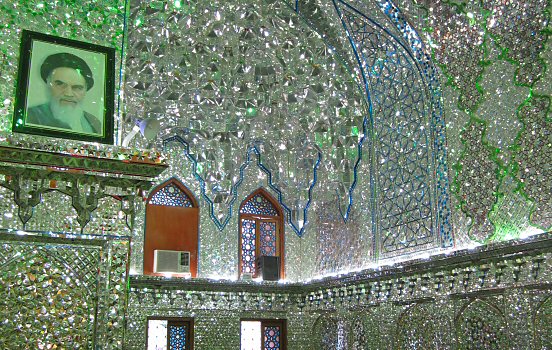 Venetian mirror work, under the watchful eye of Khomeini.
Venetian mirror work, under the watchful eye of Khomeini.
The ground outside the entrance was filled with tombstones, which supposedly cost a small fortune for the families of the deceased. A woman released gold fishes into a nearby pool, as a traditional wish for a happy life. I’ve been told that Shiraz is one of the oldest towns in Iran and it felt more conservative than Tehran.
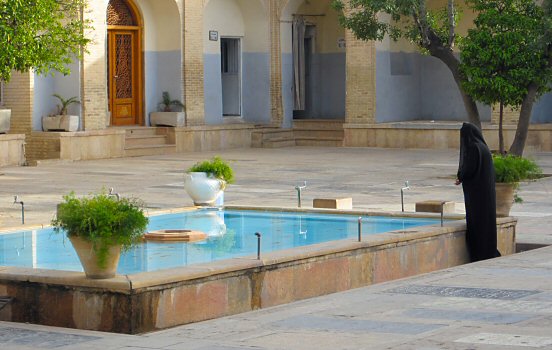 Chador-clad woman releasing gold fishes outside the shrine.
Chador-clad woman releasing gold fishes outside the shrine.
Walked north through Melli park where there was a lot of tents, as the Iranian people sure loves to picnic. I tried the odd local specialty Faloodeh, some sort of frozen starch lime juice with rose water. Weird but not bad.
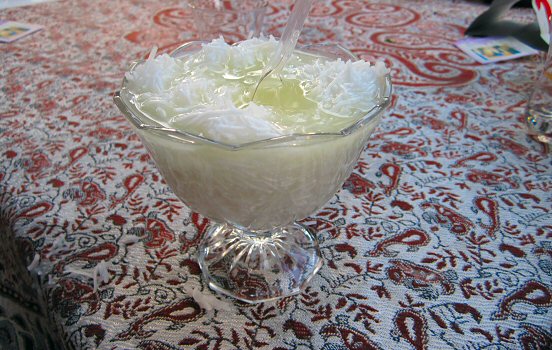 Faloodeh.
Faloodeh.
Our path led us to Aramgah-e Hafez, where the beautiful tomb of national poet Hafez brought lots of people into the night.
Getting past the crowd made me hungry, and after a long walk westbound we found the best kebab in town near the gas field. A fitting end to the evening was the furious cab ride home, so wild it should come with a helmet.
- Related blog post: Hunting for kebab in Shiraz
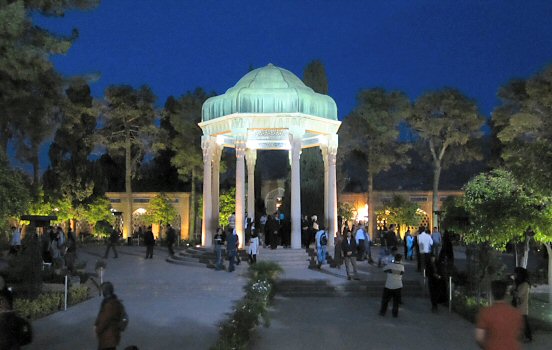 Tomb of national poet Hafez.
Tomb of national poet Hafez.
The next day we ended up at Daryache ye Namak, a salt lake outside of Shiraz. It was possible to walk quite far into the lake, which made my shoes look like they’ve been through a rough winter in Gothenburg.
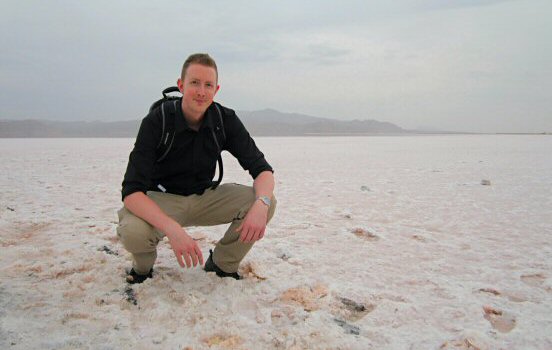 Across the salt lake, Daryache ye Namak.
Across the salt lake, Daryache ye Namak.
The winds of time in Persepolis
Persepolis is one of the great places of the ancient world. It was once the ceremonial hub of the Achaemenid Empire with large temples, before Alexander the Great decided to burn Persepolis to the ground. It was probably a retaliation for Xerxes sacking Athens about 150 years earlier. Talk about holding grudges.
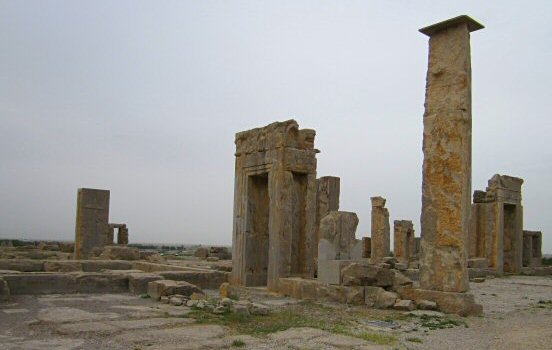 The remains of Xerxes’ Palace in Persepolis.
The remains of Xerxes’ Palace in Persepolis.
I climbed the beautiful Apadana staircase with well-preserved reliefs of majestic Persia. Much of it was carted off to the British Museum in London, but the imposing stone columns gave a hint of the former magnitude of this place. Graffiti from visitors such as Welsh explorer Stanley (visited in 1870) were seen carved into the stone here and there.
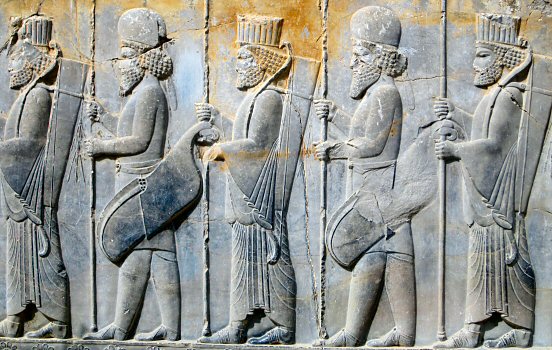 Ancient reliefs at the Apadana staircase in Persepolis.
Ancient reliefs at the Apadana staircase in Persepolis.
From an adjacent hilltop there was a great view of the entire palace area. At nearby Naqsh-e Rustam we looked upon the large royal tombs chiseled into mountainsides.
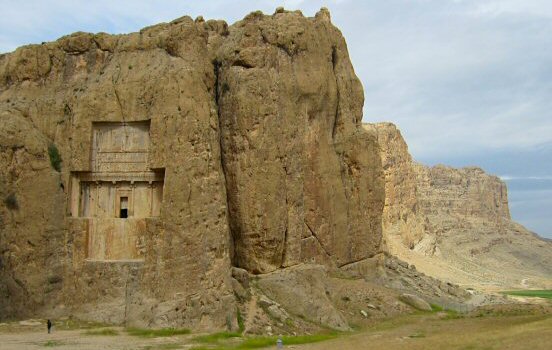 The tomb of Xerxes at Naqsh-e Rustam. Notice the human for scale.
The tomb of Xerxes at Naqsh-e Rustam. Notice the human for scale.
We managed to get a car to Pasargadae, the old capital city of Cyrus the Great. Cyrus was arguably the greatest leader of ancient Persia, praised even in the Bible for his humanitarian rule. His large tomb had already been plundered when Alexander the Great visited the site in 324 BC, about 200 years after the death of Cyrus.
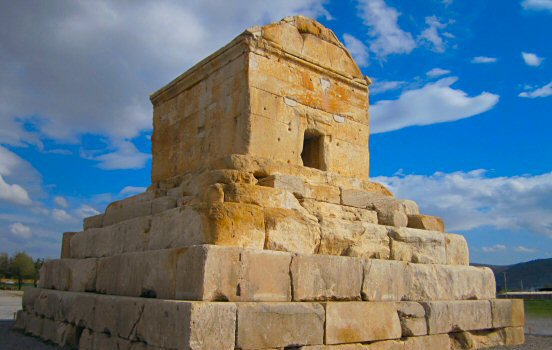 The tomb of Cyrus in Pasargadae.
The tomb of Cyrus in Pasargadae.
We explored the surrounding sites and found writings carved in columns in three different languages. The fortress of Toll-e Takht at a hilltop offered nice views of the area.
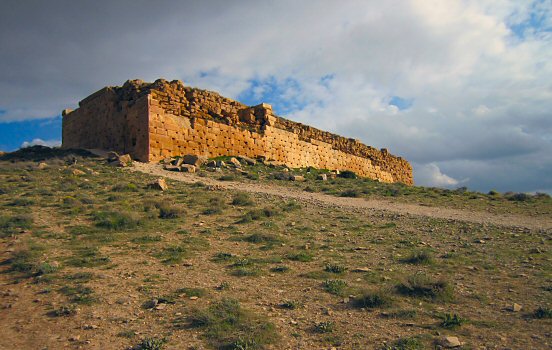 The fortress of Toll-e Takht.
The fortress of Toll-e Takht.
Desert camp
Time to leave civilization and go south. After a few hours we entered the town of Firuz Abad where we found the ruins of an 1800-year old palace called Ardashir-Kwarrah.
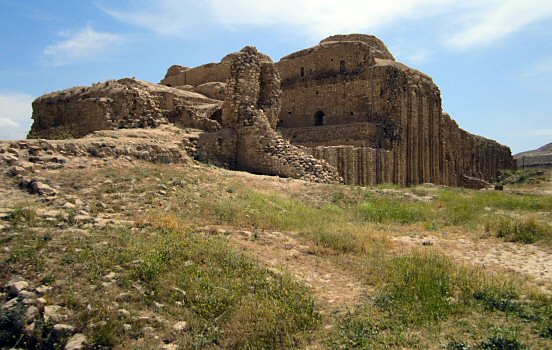 The ruins of Ardashir-Kwarrah.
The ruins of Ardashir-Kwarrah.
Among the deserted ruins were red papavers (opium poppy), a welcome splash of color in the otherwise barren site. The palace was once built by Ardashir Babakan, founder of the Sasanian empire.
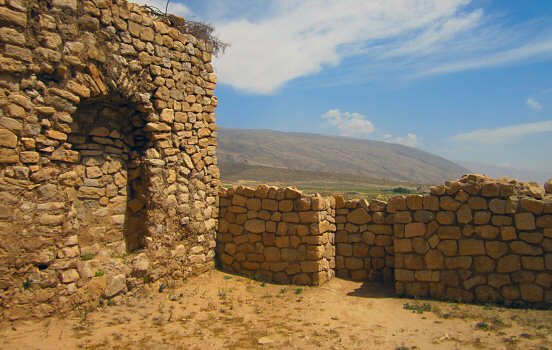 Inside Ardashir-Kwarrah.
Inside Ardashir-Kwarrah.
For several hours we rolled across steep hill roads which made the engine growl under pressure. The temperature was rising fast and we rarely saw any signs of life.
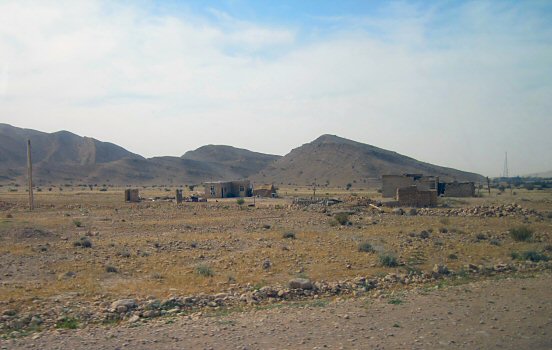 Settlements along the desert road in southern Iran.
Settlements along the desert road in southern Iran.
We finally stopped at a Kashgai nomad camp shortly heatstroke. The friendly family offered us tea, sitting on a beautiful carpet they had woven themselves.
My memory of civilization slowly peeled away, as I tagged along with the family when they picked berries from trees, farmed vegetables in the fields, milked goats and made yogurt.
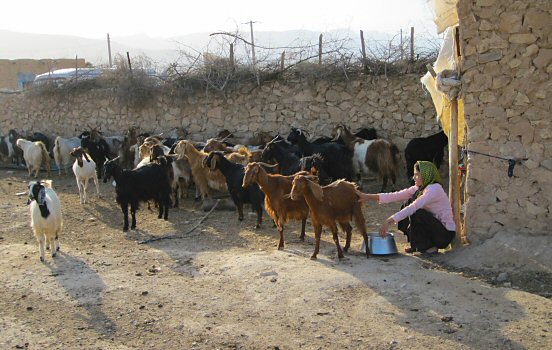 Staying with the nomads.
Staying with the nomads.
After nightfall I went on a walk alone in the dark and marveled at the impressive starry sky, completely free from light pollution. The stars were so loud I almost yelled back.
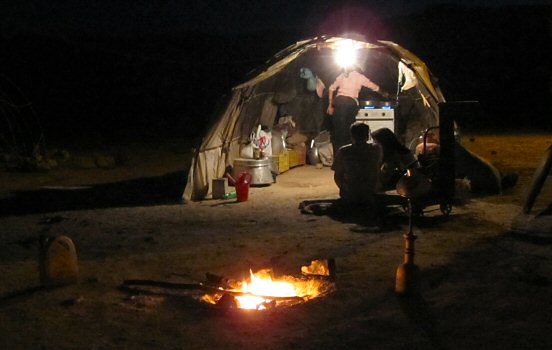 A beautiful night under the stars.
A beautiful night under the stars.
Towards Esfahan
I woke up on a Persian rug, back aching from the hard floor. A rooster had the audacity to start his day long before mine began, but luckily for him I was too tired to go hunting. The nomad family baked very tasty bread for breakfast and I thanked them for an interesting stay, which gave me perspective on our lifestyle back home.
The car engine was not happy at all to see us get back behind the wheel. Our trusty vehicle struggled to get across the hills as we headed north.
After a long journey we finally arrived in Esfahan late in the evening. Walked across the Si-o-Seh bridge with its 33 arches beautifully lit above Zayandeh river.The cool ones seemed to hang out beneath the bridge, it felt like a bad idea to ask why.
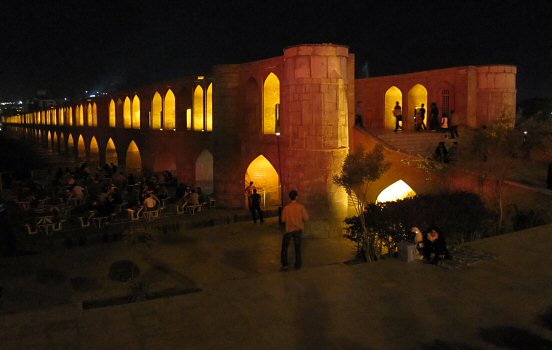 Si-o-Seh bridge in Esfahan.
Si-o-Seh bridge in Esfahan.
The next morning we walked to Imam Square, said to be the second-largest square in the world after Tiananmen Square in Beijing. There were lots of families having picnics in the grass and we misfits got lots of attention since we were probably the only non-Iranians in the entire area.
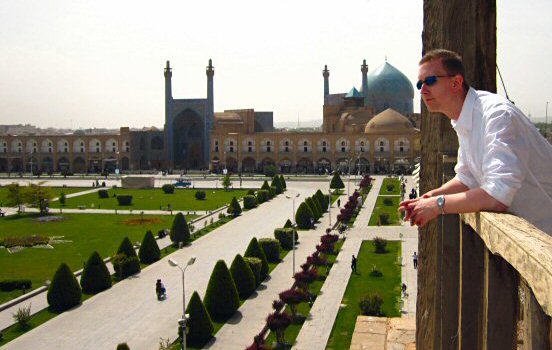 Searching for kebab at Imam Square.
Searching for kebab at Imam Square.
Managed to find our way to Azadegan Tea House, well hidden in a small alley, where we had tea and squeezed past the vast amount of junk crammed into the tiny space.
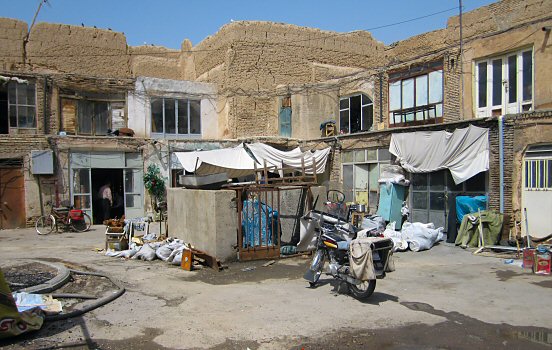 The well-hidden tea house in Esfahan.
The well-hidden tea house in Esfahan.
Then off into the bizarre bazaar where I got stared at like a frozen yogurt vendor in a polar storm. Found some sort of religious school with large Khomeini paintings on the wall. Deep in the basement we found the worst public toilet ever (a record that would last for only a few days). That was our cue and we walked back to the waterfront for an sunset walk along Zayandeh River.
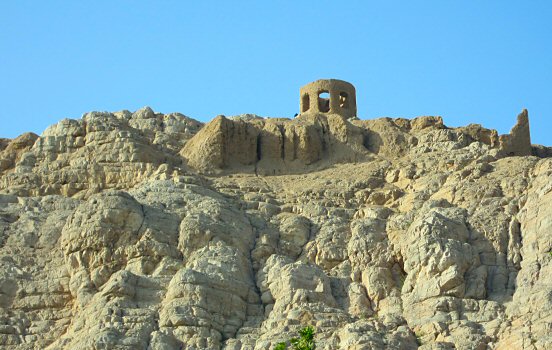 Ateshkadeh-ye Esfahan from below.
Ateshkadeh-ye Esfahan from below.
We spotted a cool mountain at the horizon and immediately went there to climb up. At the top we found the old Zoroastrian fire temple Ateshkadeh-ye Esfahan, where we sat down in the crumbling mud brick arches and had a fantastic view of the surroundings.
Back down on the ground we went looking for pigeon towers, once used to hold thousands of pigeons for a supply of guano used as fertilizer for the city’s famous fields of watermelons. More than 700 of the once 3000 towers remains, but the most interesting part was the way there that lead us through a pitch black tunnel filled with animal skeletons. Weird and wonderful.
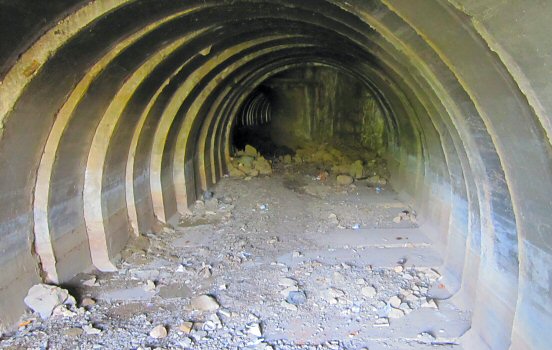 Searching for pigeon towers is not for the faint of heart.
Searching for pigeon towers is not for the faint of heart.
Back in civilization at Imam Square we joined the picnic families once again while waiting for the sun to set over the glimmering turquoise mosque domes. I had a plate of Fesenjun, the Iranian national dish with its special taste from walnut and pomegranate sauce.
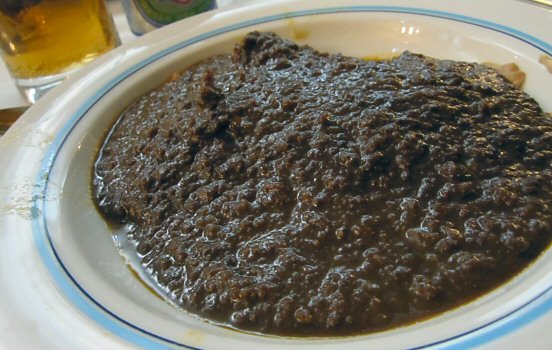 Fesenjun. It tastes better than it looks.
Fesenjun. It tastes better than it looks.
We managed to sneak into the Abbasi Jame Mosque at dusk and sat below the minarets as the muezzin chanted loud prayers while serious men in serious beards poured into the big chambers, praying on big rugs on the floor.
- Related blog post: The splendor of Esfahan
To Yazd
I really liked Esfahan, but now it was time for something completely different. We found our way to the bus station, where we entered an old bus mostly held together with prayer and duct tape. After a steaming ride through the desert we finally arrived at the ancient city Yazd.
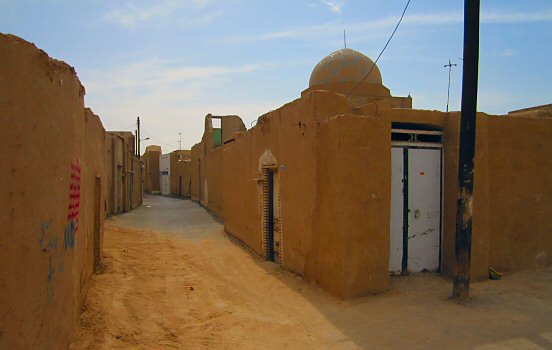 Endless mud brick alleys.
Endless mud brick alleys.
Yazd rises like a pile of bricks in the middle of the desert. The city was once a popular travel hub along the Silk Road, so extra tall minarets were once used as landmarks for camel caravans.
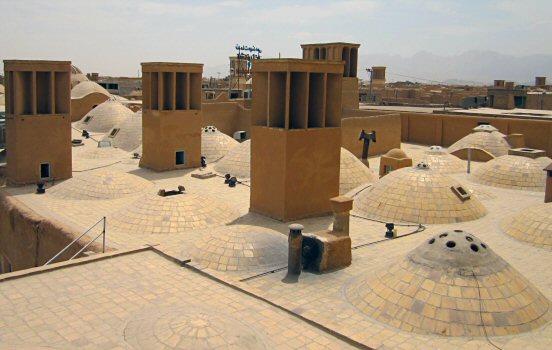 The roofs of Yazd are covered with badgirs.
The roofs of Yazd are covered with badgirs.
It turned out to be very easy to get lost in the mud brick alleys. We went up on the roof of a mosque and admired the roof tops which had a lot of “badgirs”, ingenious constructions acting as medieval air conditioning systems. The wind-catchers felt like something out of Frank Herbert’s Dune.
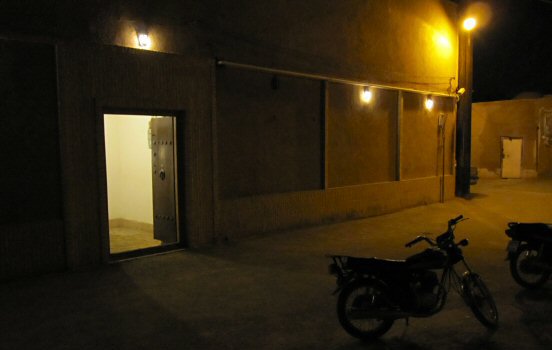 The quite discrete entrance to our hostel.
The quite discrete entrance to our hostel.
The evening ended at a weird place. Saheb A Zaman Club Zurkhaneh was an old water reservoir built in 1580, but these days it’s used as a dojo for practitioners of Zurkhaneh, a thousand-years old mix of religion and martial arts. A referee recited poetry of Hafez and beat the drum like crazy to provide a sonic backdrop for the performers whirling around in the center pit. As always we drew more attention than an ice cream vendor in Sahara.
- Related blog post: Getting lost in Yazd
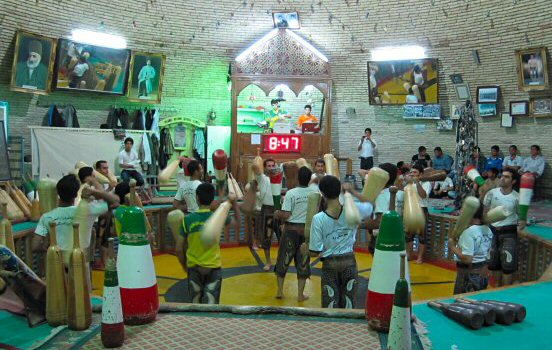 Practitioners of Zurkhaneh in action.
Practitioners of Zurkhaneh in action.
Meybod and beyond
We drove for hours into the desert before arriving at a mountain. Far up on the slopes we saw Chak Chak, the old fire temple which is the most sacred pilgrimage shrine of the Zoroastrians.
Ascending the slope was quite tough in the desert heat, but we finally reached the shimmering bronze gate. An old man unlocked the gate and we entered the shrine barefoot. To my surprise, the floor tiles were cold and wet. Next to the eternal flame was a small drizzle of water next to a very old and gnarled tree. An unexpected sight in the middle of the desert.
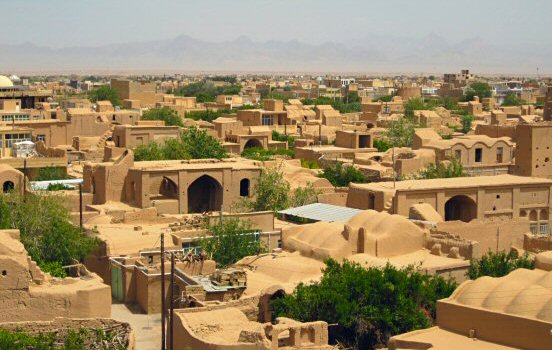 View of Meybod from the Narein castle.
View of Meybod from the Narein castle.
Later in the day we arrived in Meybod, another old trade center along the Silk Road. From the top of the Narein castle we had a great view of the mud brick city which felt really ancient.
We climbed to the top of a Tower of Silence, a place where the Zoroastrians placed their dead. After the bodies had been picked clean by vultures, the remaining bones were stored in small alcoves around the tower.
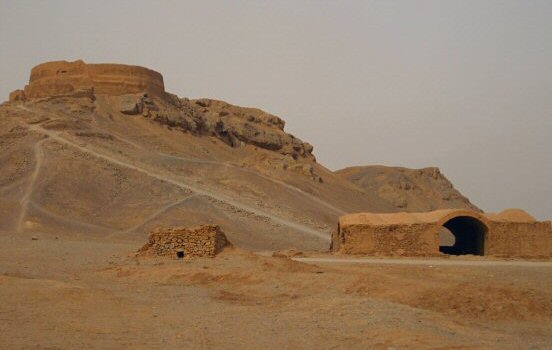 A Tower of Silence with remains of Zoroastrian buildings.
A Tower of Silence with remains of Zoroastrian buildings.
Passed through a caravansedai, which used to be sort of a camel motel, before we got to Yakh Dan, a mud brick house built to store ice during the summer. I climbed down into the egg-shaped pit, giving a nice echo to the cold chamber.
The journey east to Meymand
The day became endless hours along deserted roads through the barren stone desert. Stopped for gas in Shak-n-Babah, a chaotic trucker stop where the drivers fought for access to the pumps. I noticed several American Mack trucks among them, but they were quite old so I guess they were imported during the Shah era. This is also where I found the Worst Public Toilet Ever (unfortunately I didn’t bring any ceremonial plaque for the occasion).
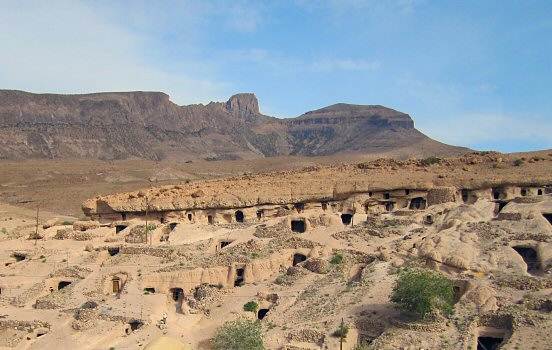 The cave village of Meymand.
The cave village of Meymand.
We finally arrived at cave village Meymand in the evening, where we got a cozy cave that would be our home for the next few days.
Went for a walk in the small village, passing the school building with Khomeini painted on the wall. There were only four children in the village, so I guess they had plenty of space. I bought some peanuts from a toothless old woman and had tea in a cave sitting on a tree log.
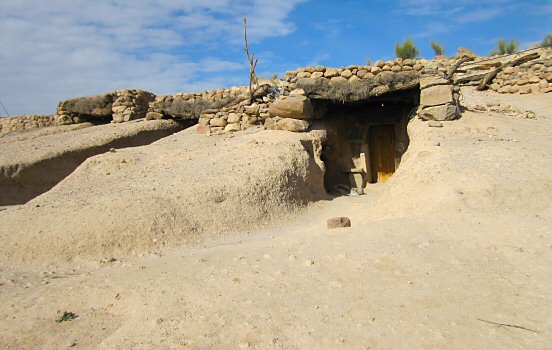 Our cozy cave in Meymand.
Our cozy cave in Meymand.
Lost in Meymand
Despite the hard surface in the cave I actually managed to get a few hours of sleep. Splashed some cold water in the face and went off trekking in the surrounding hillside. Our local guide was a young man named Ali, smiling all the time as he climbed the slopes with the energy of a mountain goat. A black dog followed us anywhere we went, but always at a respectable distance, like a shadow with a tail..
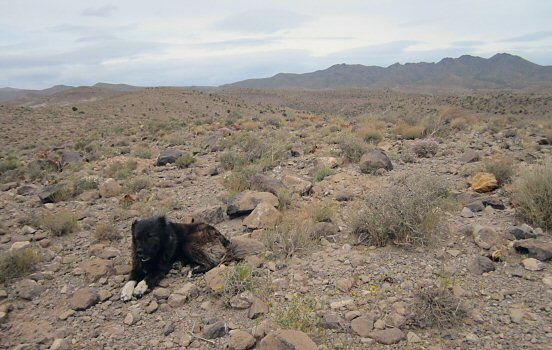 The poor black dog followed us everywhere we went.
The poor black dog followed us everywhere we went.
Along the way we came across farmers who gave us almonds, and later we stumbled upon a family picnic where we were instantly invited to share their abundance of tea, dates and bread.
After a few hours of walking we were invited to a small hut where we had omelet with dates, and of course more tea.
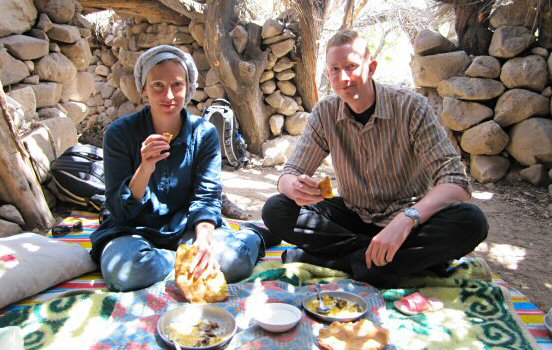 Invited for tea somewhere in nowhere.
Invited for tea somewhere in nowhere.
Arriving in Kerman
After spending several days in a quiet cave, it felt like a shock to arrive in Kerman during the afternoon. Hello again, traffic mayhem.
After leaving the backpacks at a dirty hotel we walked through the bazaar. In an old haman we found a tea house, where I tried the local cookie Kolompeh, while two men played music in a corner and several visitors leisurely smoked on water pipes. Civilization, how I have missed thee.
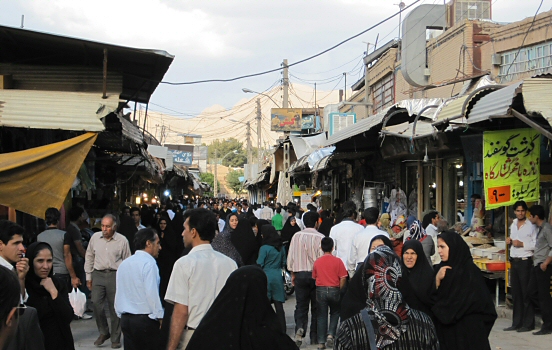 The bazaar in Kerman.
The bazaar in Kerman.
We were later invited to a friendly family where we had good things to eat. I am constantly amazed at the hospitality of the Iranian people.
Exploring Dasht-e Lut
The city of Bam once had a beautiful citadel, but it was destroyed in the 2003 earthquake. Instead we went to the nearby town Rayen. The old mud brick citadel had with a nice backdrop view of snowclad mountains. Everything went well until the guards yelled at me for dancing. Time to leave.
Next stop Mahan, where we visited the mausoleum of sufi leader Shah Ne’emat Ollah-e-Vali. For some reason we climbed up one of the twin minarets. It was quite narrow but worth the hassle with a nice view of the turquoise tiled dome. After meeting a red snake in the toilet, we decided to take off.
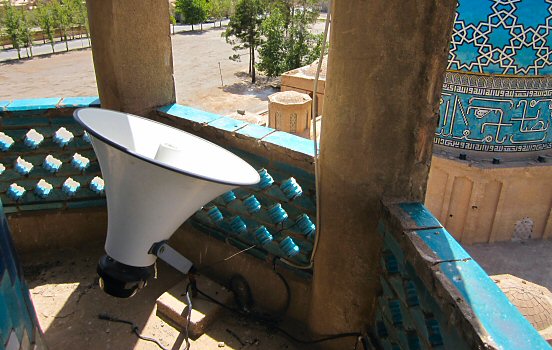 Unusual place #23: The top of a minaret.
Unusual place #23: The top of a minaret.
We rolled east into the Dasht-e Lut. The Lut desert is a barren place where the highest ever temperature was once measured, a scorching +70 degrees Celsius. The area is known for the kaluts, big sand castles which reminded me of Monument Valley in North America.
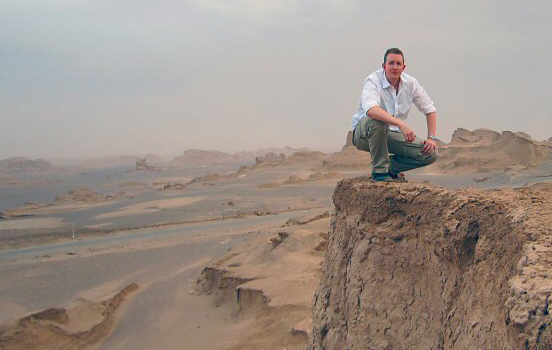 Exploring kaluts in Dasht-e Lut.
Exploring kaluts in Dasht-e Lut.
We left the vehicle and started to ascend the mighty slopes of the kaluts. Sat down on a ridge and enjoyed the tranquil sunset over the kalut horizon.
Northbound train
No rest for the wicked. Time to put on the backpack once again and head for the train station in Kerman. It turned out to be as chaotic as expected, but as soon as we settled in our cabin, things got better. We were offered tea by the train steward and there were even some strange cookies. The barren landscape passed outside the window but at least there were pretty mountains and even the occasional wild dromedary.
Suddenly the train stopped in the evening so passengers could get off to say their prayers. We were likely the only people left on the train, waiting impatiently.
There was an ongoing feud with the cabin next door regarding the wagon temperature. The women clad in heavy chadors said that the desert heat was too cold and insisted on increasing the temperature. I woke up in the middle of the night, close to fainting from the heat before I managed to crawl to the window and push it open for cold air like a fish on dry land.
Entering Mashhad
Our night train arrived in Mashhad early in the morning. This is a pilgrim city close to Afghanistan which holds the shrine of Imam Reza, the eight Imam. The other eleven are buried in Iraq and other places, so this is the holiest site in Iran.
As non-Muslims we were not allowed to enter the innermost sanctum, but we watched from a distance as large crowds gathered to pray. The shrine is like a city within the city, filled with domes, fountains and courtyards. The area is so large that there is even a freeway intersection below it.
What to do next? Explored the bazaar area, had great kebab and got free cookies!
Back to Tehran
In the morning we went back to the train station of Mashhad, which fortunately was somewhat better than the one in Kerman.
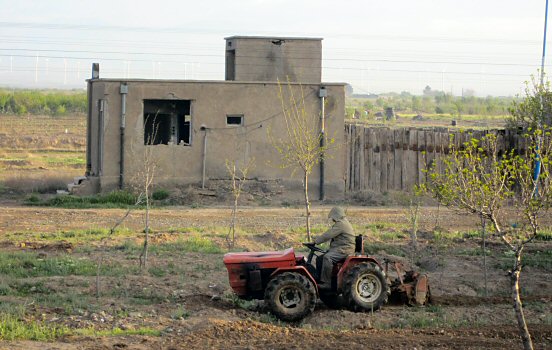 One of the magnificent train stations.
One of the magnificent train stations.
The westbound train ride went pretty smooth and I saw beautiful mountains in the countryside, including Fuji-shaped mountain Damavand in the distance as we got closer to Tehran.
The streets of Tehran
I woke up in Tehran to the sound of prayer chants at 5 AM. Today it was time to explore the northern parts. The entire city is built on the slopes below snowclad Alborz mountains and for half an hour we traveled constantly uphill. The mountains in the north turned out to be good for orientation since they are visible from most places in the city.
We found our way to the Sa’d Abad Museum, the luxury complex where the shah used to live. Only the legs remained of the statue of Reza Shah in front of the White Palace. Had a look inside the various palaces and weapon museums to learn more of this turbulent era.
Tehran is the largest city in the Middle East and today it really lived up to the name as we passed lots of blocks and it just never seemed to end. The National Museum turned out to be a disappointment though. Only a few of the items were from Persepolis, as the rest had unfortunately been shipped to British Museum in London.
- Related blog post: Tales from Tehran
Epilogue
Some parts of the country will force you to leave your comfort zone and it can unfortunately be quite challenging for female travelers, but I found the people to be very friendly and the sights are nothing short of spectacular.

20 comments
Leave a reply